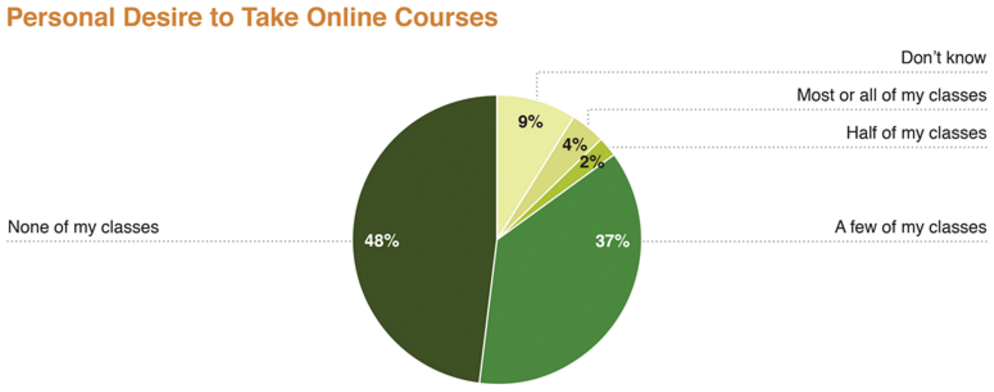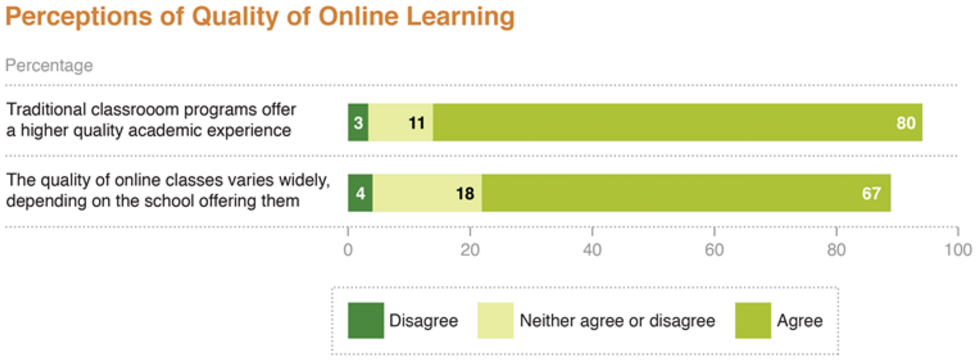You have /5 articles left.
Sign up for a free account or log in.
Most college-bound high school students are concerned about the quality of online education, but many say they are open to the idea of taking some of their courses online, a new study shows.
But the most recent issue of the studentPOLL, published by the standardized test provider ACT and the consulting firm Art & Science Group, suggests incoming college students still believe they will pursue higher education the traditional way: by attending most of their courses in person.
Among the students surveyed for the studentPOLL, 85 percent of respondents said they wanted to take a majority of their courses in person, but only 6 percent said they were open to the idea of taking half, most or all of them online. About one-third (37 percent) said they could see themselves taking a handful of online courses, while 9 percent were undecided.
Those results highlight the differences between soon-to-be high school graduates and adult students, a much larger segment of the millions enrolled at colleges and universities in the U.S. and whose professional or personal obligations have been an important driver for the growth in the online education market. Over all, federal higher education enrollment data show about one in every seven students studies exclusively online, while more than one-quarter of students take at least one online course.
Conversely, colleges rarely build fully online programs intended for students just out of high school, a pool that is flattening (and in some regions declining). Among those that have, such as the University of Florida, online education is often used as a safety valve that allows institutions to enroll more students than can physically fit on campus. Of course, many colleges use online platforms and tools to augment face-to-face courses.
The survey responses for the studentPOLL were gathered in February 2015 from students who took the ACT the previous fall. Only students who said they intended to enroll in a four-year program in fall 2015 were selected for the survey. The results are consistent across subgroups such as gender, ethnicity and income level.
Richard A. Hesel, a principal at the Art & Science Group, said that -- from the perspective of a consultant -- he would be hesitant to advise a small college to market fully online programs to high school students.
“I wouldn’t make it a centerpiece of what you’re trying to appeal to them about,” Hesel said in an interview. “This generation is expecting a traditional experience.”
Jeff Seaman, co-director of the Babson Survey Research Group, another organization that routinely examines the online education market, said colleges looking to break into the online undergraduate market should not be deterred by the results of the studentPOLL. He pointed out that even though the students who said they were interested in taking many of their courses online number in the few percentage points, the results actually suggest tens of thousands of students are interested in studying online. In 2015, for example, 1,924,436 students took the ACT.
“That’s still a sizable number compared to what the supply side is,” Seaman, whose organization has provided annual snapshots of the online education market, said in an interview.
Russell Poulin, director of policy and analysis at the WICHE Cooperative for Educational Technologies (WCET), criticized the authors of the study for designing it around “preconceptions” about online education. Their analysis, he said in an email, reinforces the presumption that high school students aren’t interested in studying online.
“Since when is 43 percent of the students equated with ‘almost no interest’?” Poulin wrote, referring to the surveyed students who said they were interested in taking a few, half or most of their courses online. The undecided students, he added, shouldn’t be assumed to be negative toward online education. “Perhaps they would be interested if they try it?” he wrote.
While many students are open to their college experience involving at least some online education, a large majority of the survey respondents said those courses can’t beat the quality of education they receive in the classroom. Four out of five students said face-to-face courses offer a “higher-quality academic experience” than online courses. A mere 3 percent disagreed, while an additional 11 percent neither agreed nor disagreed.
If there is a silver lining for online education advocates, it may be that two-thirds of students believe the quality of online education varies from one college to another. Only 4 percent of respondents disagreed with that statement.
Poulin warned against reading too much into those results. He argued that since many people associate the term “online learning” with massive open online courses and diploma mills, there are bound to be misperceptions. Studies that have looked at student outcomes from online courses have found them to be generally equal to those from face-to-face courses.
“We need to be clear that this is a survey on perceptions and not experience,” Poulin wrote.






